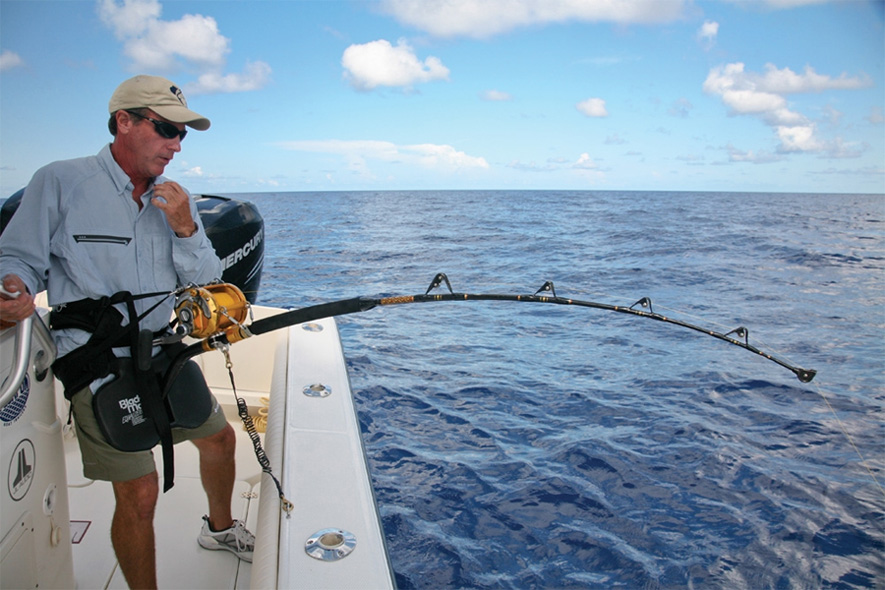"So, this is how I'm going to die.'� That thought entered my mind as I hit the water, hitched to a big swordfish on 80-pound-class stand-up tackle. My second thought was: 'No, it's not!'� as I backed off the drag to keep the fish from pulling me under, slowly so the line wouldn't backlash and jam in the reel. Nick Stanczyk and I were off Islamorada, in the Florida Keys, shooting a daytime swordfish episode. All was well until the wake of the camera boat hit our boat, knocking me off-balance and sending me overboard.
This was the first time in my life I had ever exited a boat unceremoniously. If anyone doubts how easily he can perish in an accident, he needs to rethink it. As well-thought-out as my emergency plan was, weaknesses �surfaced, and I came away from that incident with a revamped strategy to ensure any angler on my boat will swim away from a bad situation with nothing more than hurt feelings.
Sure Footing
Never overlook the value of performance footwear on a boat. I wear sneaker-style shoes with thick soles for secure grip in wet and dry cockpits. Wearing sandals or going barefoot is foolhardy. In a grueling fight on stand-up gear, negotiating cockpits strewn with coolers, gear and fish, exposed toes or bare feet can get you into trouble.
Tag Team
I have one person standing behind the angler who is hooked up. If it's just me and a friend, I'll do my best to spot him while he pumps and winds, and will attend to the helm when necessary. Spotting serves two purposes: Should the angler slip or lose balance, he can be righted. Some harnesses have handgrips expressly for this. Second, the spotter can prevent a fall and injury should the hook pull or line break while he is deep into a squat or leaning back on a pump.
Line Dance
I keep safety lines aboard to ensure against expensive outfits and anglers being lost overboard. The day I went overboard I had opted not to use them. This poor decision could have resulted in my drowning. My lines will now always be used with large fish and stand-up tackle aboard my boat. Make certain that safety lines are long enough to allow movement around the cockpit based on the boat you are in. Also make sure both the lines and �the hardware you select are more than strong enough to handle an emergency.
Mind Over Emergency
In a dire situation you might have only seconds to react. You need a clear and focused mind, and a �previsualized self-rescue plan. I had played out such a plan in my mind often: If I found myself overboard and attached to a large fish, my first response would be to slowly back off the drag, neutralizing the force and weight of the fish dragging me to a watery grave. Next, I'd pull the outfit to my chest, unclip the reel from the harness, and swim out of it. In a worst-case scenario, I had my pliers to cut the fishing line.
Steps two and three didn't work out. I recall backing off the drag and alleviating the pressure, but my head was barely above water, and I could not reach the rod to unclip it. Later, the footage revealed the rod had been pulled straight down between my legs. The reel was attached to my harness, but reversed. With a knife I could have cut the line, but I had only pliers, and they were beneath the harness belt. Especially frightening, watching the footage later, was the realization that had the braided line fouled around the rod tip, or one of my feet, it would have rendered the free-spool mode useless; I had no safety line, so I would have indeed been pulled down.
Cut to the Chase
I carry pliers for tending to terminal gear, but relying on them in a life-threatening situation, when they are on your belt under the harness, can have disastrous consequences. Enter the fishing knife '’’ more specifically, the cutting tool '’’ that can whack through monofilament and braided lines. I keep one on me, and additional cutters affixed to rod belts and harnesses where they're accessible. These tools are attached to cords so there's no risk of losing them.
George's Happy Ending
.jpg)
In my case, Kevin Tierney dove off the camera boat and came to my rescue (he later told me it was because he wasn't sure if my wife had check-signing authority for my business). Stanczyk and Tierney were able to help lift the rod enough for me to unhook and swim out. Like all good cowboys, I got right back on the horse. I rolled into the splashwell, stepped into the cockpit, got back to fighting that fish and whipped the 256-pounder just as the sun was setting.
Until this incident, I thought I had a sound safety plan in place. Things can happen quickly out on the ocean, and there is absolutely no room for compromising safety. In fact, every offshore angler should re-evaluate his emergency plan, safety equipment and its accessibility under duress.
Whether you're harnessed up to fight fish from a midsize center console or from the Queen Mary, use those safety lines. They might keep the sun from setting on you, or one of your anglers.

Wiring the Big Ones
Jeffrey Liederman, who has worked the cockpit for some of the best big-game tournament boats in the �Caribbean and South Florida, says a fishing knife is a must-have item for all wire men and deck hands.
Liederman tucks two of these in his pants, where he can get to one in an instant. In addition, when wiring a large fish, the mates shadow each other. Should the wire man get into trouble, the other team member is right there to use the knife and save that wire man from injury. Unlike the angler who benefits by using a safety line, �Liederman feels it is impractical for a wire man to be tethered, due to the mobility needed to move about and handle fish boat-side. In this case, the line could prove a danger to �others in the cockpit.


